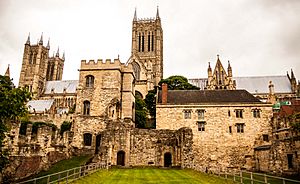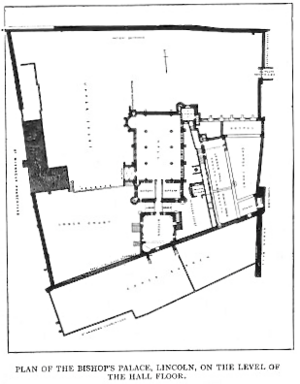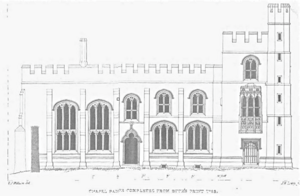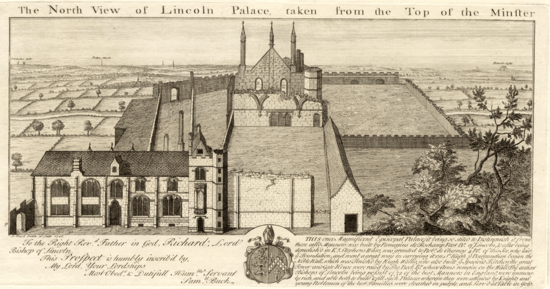Lincoln Medieval Bishop's Palace facts for kids
Quick facts for kids Lincoln Bishop’s Palace |
|
|---|---|

Bishops Palace Lincoln, looking towards the Cathedral
|
|
| Location | Entrance from Minster Yard, S of Cathedral |
| OS grid reference | SK9778671662 |
| Founded | c1175 |
| Demolished | Partially during English Civil War |
| Governing body | English Heritage |
| Official name: Bishops Palace (Remains), Lincoln | |
| Type | Grade I |
| Designated | 8 October 1953 |
| Reference no. | 486138 |
| Lua error in Module:Location_map at line 420: attempt to index field 'wikibase' (a nil value). | |
The Old Bishop's Palace is a fascinating historic place to visit in Lincoln, Lincolnshire. When it was first built in the late 1100s, it was a very important building. It was the main home for the Bishop of Lincoln, who was a powerful church leader. His area, called a diocese, stretched from the Humber to the Thames!
This palace was one of the most amazing buildings in medieval England. It showed how much power and wealth the bishops of Lincoln had. It sits on a beautiful hillside, just below Lincoln Cathedral. From here, you can see great views over the city. The palace is right next to the old Roman wall, which became the medieval wall protecting the 'Bail' area. This area included both Lincoln Castle and Lincoln Cathedral.
Sadly, the palace was damaged during the Civil War in the 1600s. After that, it was mostly left empty. For a while, the Bishop lived at Buckden Palace instead. Later, in 1841, the Lincoln diocese became smaller. The Bishop then moved to Riseholme, north of Lincoln. This new home wasn't very handy, so it was sold.
In 1886, an older building on the palace grounds was rebuilt and made bigger. This was done in a style that looked like Tudor buildings. Then, in 1888, part of the old Great Hall was changed into a chapel for the Bishop.
By 1945, this palace was thought to be too big. So, in 1948, the Bishop moved to a different house closer to the cathedral. The Victorian part of the palace later became a retreat centre. Since 2009, it has been a hotel called the Old Palace Hotel.
The ruined parts of the medieval palace were taken care of by the government in 1954. Today, English Heritage looks after them. They have worked to restore parts, dig up old foundations, and help people understand the history. A new garden was designed in 2001, and a vineyard was planted again in 2012.
Contents
Discovering the Palace's Past
We know a lot about the Bishop's Palace thanks to people who studied it long ago. One important person was Edward James Willson. He was a surveyor for the Cathedral in the 1840s. Willson made detailed drawings of the ruins as they were then. He also looked at old pieces of the building.
From his work, and with his son Thomas, they drew pictures showing how the palace might have looked in medieval times. Willson also used old documents from the Lincoln Cathedral Library. One very helpful document was a detailed survey of the palace made in 1647. This was done by people from Parliament during the English Civil War.
When you compare these old records with a drawing made by Samuel Buck in 1726, you can see how much of the building was destroyed during the Civil War. Willson shared his findings with a group called The Archaeological Institute in 1848.
Drawings by Hieronymus Grimm
In the 1780s, an artist from Switzerland named Hieronymus Grimm drew the ruins of the Bishop's Palace in great detail. He was working for the Dean of Lincoln at the time. These drawings are important because they show the palace when it was very ruined, before any big repairs were done in the 1800s.
His drawings include a view of the Alnwick tower. This tower had a special window called an oriel window, but in Grimm's drawing, it didn't have glass. The tower also didn't have its current small towers or battlements yet. Other drawings show the west side of the Great Hall and views from the south. One drawing, looking towards the Cathedral, shows the house that would later become the Bishop's Palace in 1886.
Old Drawings of the Bishop's Palace
Key Parts of the Palace
The most famous part of the palace that is still standing is the East Hall. This hall was built over a basement area called an undercroft. It was started by Bishop St Hugh of Lincoln and finished in the 1230s.
Other buildings, like a bigger chapel and a tower gatehouse, were added later. These were built by Bishop William Alnwick between 1436 and 1450.
Palace Pictures
See Also
Other Homes of the Bishop of Lincoln
- Buckden Palace
- Lyddington Bede House
- Nettleham, Lincolnshire.
- Stow, Lincolnshire















